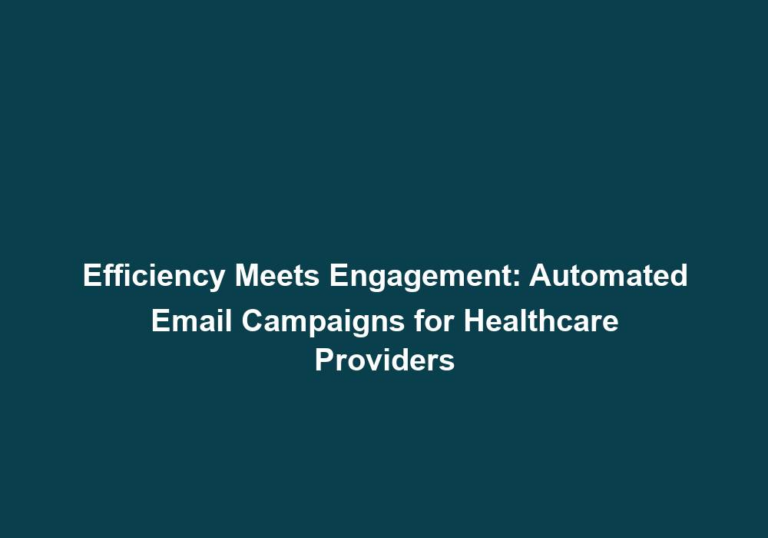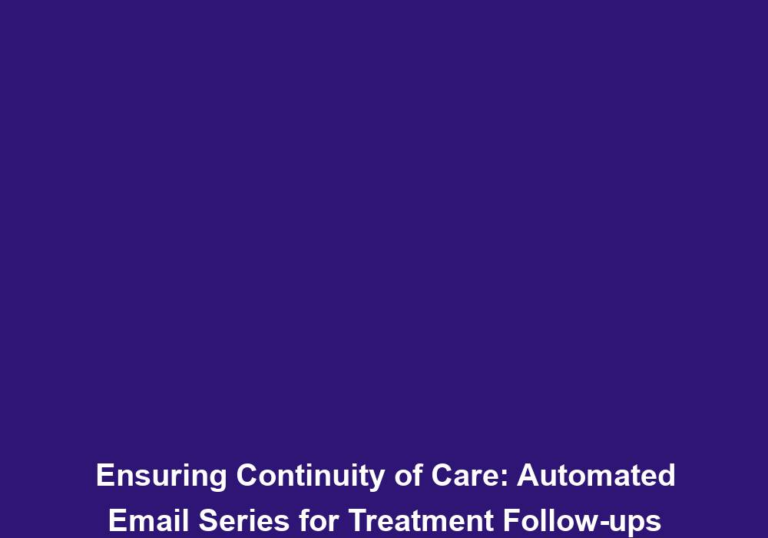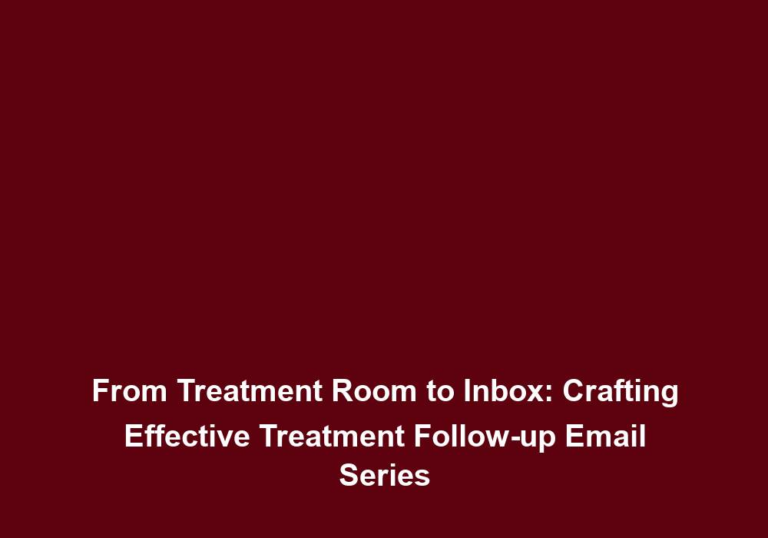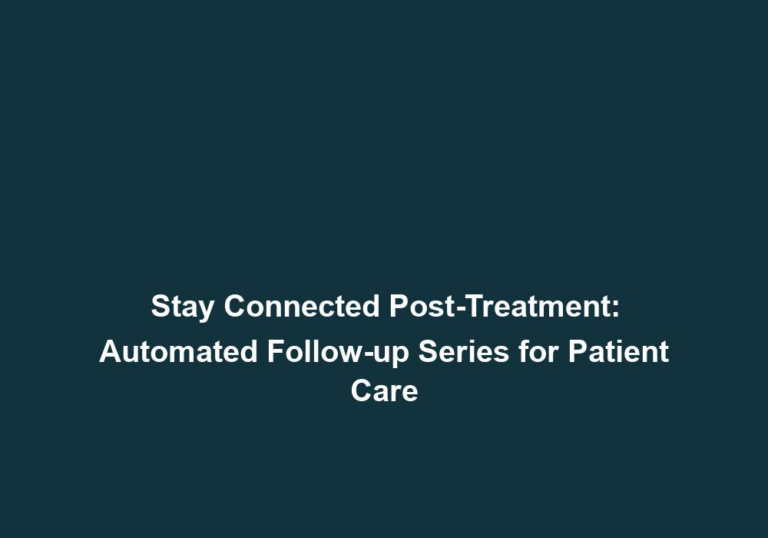Seamless Transitions: Automated Onboarding Campaigns for New Patients
In the healthcare industry, providing a seamless and efficient onboarding process for new patients is crucial. It sets the tone for their entire experience with your practice and greatly impacts their satisfaction and loyalty. This is where automated onboarding campaigns come into play, revolutionizing the way healthcare providers engage with their patients.
The Importance of Onboarding Campaigns
An effective onboarding campaign serves as a warm welcome for new patients, guiding them through the necessary steps and information to ensure a smooth transition into your practice. It goes beyond simply sending a welcome email; it involves a strategic and automated approach to engage, educate, and create a connection with your patients from the very beginning.
1. Building Trust and Confidence
An automated onboarding campaign allows you to showcase your expertise, professionalism, and dedication to patient care right from the start. By providing valuable information about your practice, your team, and the services you offer, you can instill trust and confidence in your new patients. This helps differentiate your practice from competitors and sets the stage for a strong patient-provider relationship.
- In the initial welcome email, introduce your practice and highlight any accolades, certifications, or specializations that make you stand out.
- Provide a brief overview of your team members, including their qualifications and areas of expertise.
- Highlight the range of services offered, emphasizing any unique or specialized treatments available.
By including this information in your onboarding campaign, you demonstrate transparency and establish a foundation of trust with your new patients.
2. Streamlining the Process
Gone are the days of overwhelming paperwork and manual processes. Automated onboarding campaigns simplify and streamline the onboarding process for both patients and your staff. By leveraging technology, you can eliminate tedious administrative tasks, reduce errors, and ensure that all necessary information is collected in a timely manner. This not only saves time but also enhances the overall patient experience.
- Create an online patient portal where new patients can easily complete and submit necessary forms and paperwork.
- Implement electronic signatures to eliminate the need for physical signatures on consent forms and other documents.
- Utilize automated appointment scheduling systems to offer convenient and efficient booking options for new patients.
By embracing automation, you remove barriers to a seamless onboarding experience and create a more efficient and user-friendly process for both patients and staff.
3. Personalized Patient Experience
Every patient is unique and has different needs and preferences. An automated onboarding campaign allows you to tailor the experience to each individual, providing personalized information based on their specific condition, treatment plan, or preferences. This level of customization not only demonstrates your commitment to patient-centered care but also fosters a sense of belonging and engagement with your practice.
- Use patient surveys or questionnaires to gather relevant information about their medical history, preferences, and goals.
- Based on the collected data, segment your patient list and create targeted email workflows that deliver personalized content.
- Provide resources and educational materials that are specific to the patient’s condition or treatment plan.
By personalizing the onboarding experience, you show your patients that you understand their unique needs and are dedicated to providing them with tailored care and support.
4. Education and Empowerment
One of the primary goals of onboarding campaigns is to educate patients about their condition, treatment options, and the services available to them. By providing valuable resources, such as educational articles, videos, or downloadable guides, you can empower your patients to take an active role in their healthcare journey. This not only improves patient satisfaction but also leads to better treatment outcomes.
- Create a series of educational emails that cover common conditions, treatment options, and preventive care measures.
- Develop video tutorials or webinars that explain complex medical procedures or provide tips for managing specific health conditions.
- Offer downloadable guides or brochures that summarize important information and resources for patients to reference.
By equipping patients with knowledge and resources, you empower them to make informed decisions about their health and actively participate in their own care.
Implementing an Automated Onboarding Campaign
Now that we understand the importance of automated onboarding campaigns, let’s explore the necessary steps to implement one successfully.
1. Define Your Objectives
Before diving into the campaign creation process, clearly define your objectives. What do you want to achieve with your onboarding campaign? Are you aiming to reduce patient drop-offs, increase patient engagement, or improve patient satisfaction? Understanding your goals will help you design a campaign that aligns with your overall business strategy.
- Identify specific metrics or key performance indicators (KPIs) that you want to improve through your onboarding campaign.
- Set realistic and measurable goals, such as increasing appointment show rates by 10% or reducing patient churn by 20%.
- Use your objectives as a guide to determine the content, messaging, and automation workflows for your campaign.
By establishing clear objectives, you ensure that your onboarding campaign is purposeful and targeted, driving the desired results.
2. Map Out the Patient Journey
To create a seamless onboarding experience, it’s crucial to map out the patient journey. Identify all touchpoints where patients interact with your practice, from the initial contact to the first appointment and beyond. This will help you determine the key moments to engage patients and provide relevant information.
- Start by documenting the various steps a patient goes through when they first contact your practice, including phone calls, online inquiries, or referrals.
- Identify potential pain points or areas where patients may feel confused or overwhelmed.
- Determine the best channels and methods for communication at each stage of the patient journey.
By understanding the patient journey, you can strategically design your onboarding campaign to address specific touchpoints and ensure a smooth transition for new patients.
3. Develop Compelling Content
Content is the driving force behind any successful onboarding campaign. Create compelling and informative content that addresses the needs and concerns of your patients at each stage of their journey. This can include welcome emails, appointment reminders, educational resources, and follow-up communications. Remember to keep the tone conversational and empathetic, making patients feel valued and supported.
- Craft a warm and personalized welcome email that introduces new patients to your practice and sets expectations for their upcoming visit.
- Develop a series of informative emails that provide valuable resources, educational content, and tips for managing common health conditions.
- Create appointment reminders that include important details, such as date, time, location, and any necessary preparation instructions.
By delivering relevant and engaging content, you keep patients informed and connected throughout their onboarding process and beyond.
4. Leverage Automation Tools
To truly automate your onboarding campaign, leverage email marketing and automation tools. These tools allow you to create workflows and triggers that automatically send out the right content at the right time. You can segment your patient list based on demographics, conditions, or appointment types to ensure personalized communication.
- Choose a reliable email marketing platform that offers automation capabilities, such as Mailchimp, HubSpot, or ActiveCampaign.
- Set up automated workflows that trigger specific emails based on predefined conditions, such as scheduling an appointment or completing a survey.
- Use segmentation to target different patient groups with tailored content, ensuring that each recipient receives information relevant to their needs.
By harnessing the power of automation tools, you streamline the delivery of your onboarding campaign and ensure that the right message reaches the right patient at the right time.
5. Monitor and Optimize
Launching your onboarding campaign is just the beginning. Continuously monitor the performance of your campaign and gather feedback from patients to identify areas for improvement. Analyze key metrics such as open rates, click-through rates, and patient feedback to optimize your campaign and enhance the patient experience.
- Regularly review email engagement metrics to determine which emails are resonating with patients and adjust your content accordingly.
- Collect patient feedback through surveys or feedback forms to understand their satisfaction levels and identify areas that need improvement.
- A/B test different subject lines, content formats, or calls to action to optimize your emails for better performance.
By actively monitoring and optimizing your onboarding campaign, you ensure that it remains effective and aligns with the evolving needs and preferences of your patients.
Conclusion
Automated onboarding campaigns have transformed the way healthcare providers engage with their new patients. By providing a seamless and personalized experience, these campaigns build trust, streamline processes, educate patients, and ultimately improve patient satisfaction and outcomes. Implementing an automated onboarding campaign requires careful planning, compelling content, and the use of automation tools. With a well-executed campaign, you can create a strong foundation for long-lasting patient-provider relationships.







